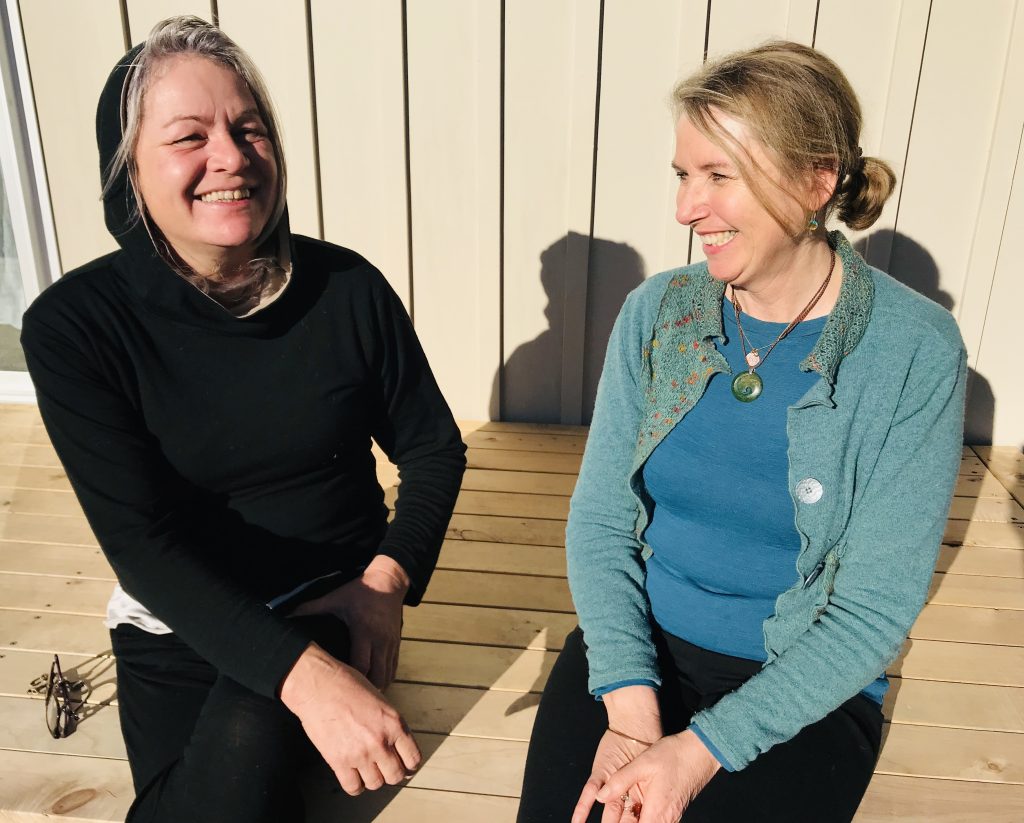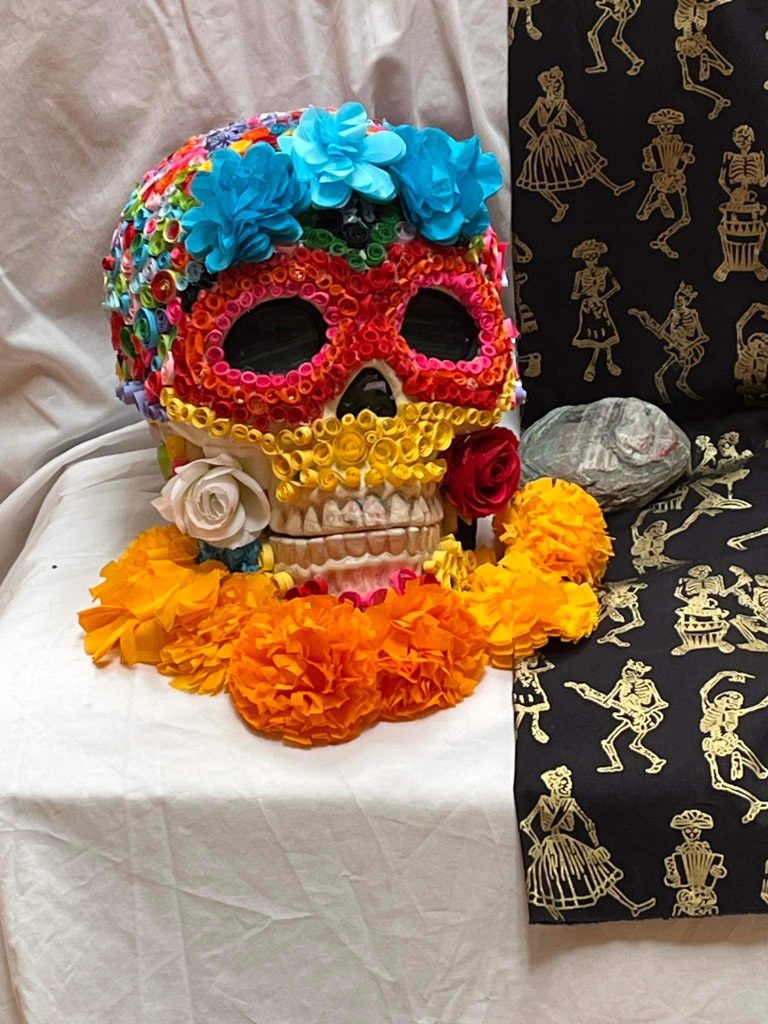There’s no telling when death might tap you on the shoulder. When your name is called, there are no ifs or buts; as the saying goes, “you can be a king or street sweeper, but everyone dances with the Grim Reaper.” Many of us spend our time avoiding this fact. Others, however, invite it in for tea.
On a warm spring afternoon on the outdoor patio at Ruby’s Cinema & Bar in Wānaka, the Death Cafe is gathering. Seventeen of us are crammed around a long table ̶ most over 50, with a smattering of 30-somethings and a six-month-old. The table fills with hot chocolates, kombuchas, iced coffees, cups of tea and baked treats. We’re here to talk about death.
The gathering is led by Liz Maluschnig and Su Hoskin, who settle the chatter with an introduction. Liz is a marriage and funeral celebrant, counsellor and former oncology nurse, whilst Su has a background in biodynamic agriculture, and, more recently, in palliative care, so far just for a few close friends.
“This is not a grief support group,” Liz tells us, “but it is a safe and respectful space. The objective is to increase the awareness of death to help us all make the most of our lives.”
This is not a new concept; as many people who have had a close brush with their own mortality may tell you, it can be remarkably enlivening. In our death-denying, don’t-look-at-it-and-it-might-go-away culture, the reaper’s breath on our neck can serve as a much-needed bucket of cold water over the head. As the doctor and writer Oliver Sacks observed after learning of his terminal cancer in his eighties, “I feel a sudden clear focus and perspective. There is no time for anything inessential.”
Everyone introduces themselves. It’s up to the group to steer the conversation, and we do. If someone has something to discuss, it goes on Liz’s list of topics, which we’ll work our way through. This afternoon’s subject matter is broad, and existentialism aside, there are also logistics to consider.

Brenda* wants to know about composting bodies. Jim has a bone to pick on the topic of natural burial grounds: can flax bushes really take the place of gravestones? Someone else wants to know how to plan a funeral on a budget (the average funeral in New Zealand costs $10,000), and several are keen to discuss death semantics (died versus passed away versus kicked the bucket and so on). Jill wants to talk AI and relationship guru Esther Perel. We’ll come back to her.
Before we get stuck in, Liz shares a bit of history. The Death Cafe, she tells us, is a global movement, and there are thousands just like this one happening all around the world. They were started in 2010 by an English chap called Jon Underwood (recently deceased, we assume well-prepared for the occasion).
Jon was researching death and dying and decided to organise some discussions to see what people had to say. His mother was a psychotherapist, so she put her hand up to facilitate the meetings, which, being set in the United Kingdom, were always accompanied by cake and tea. “Apparently they had a wonderful time,” Liz says, and so began the Death Cafe movement, which provides safe spaces to talk about the often-tabooed matter of our final exit.
“Okay, so I listen to Esther Perel,” Jill says, to nods and murmurs of recognition from the group. Esther is a famous Belgian couples therapist and relationship expert. “There was this situation, where somebody was so desperate to have therapy with her that they recreated her with AI. My gut reaction was, ‘How horrible, how invasive.’ I texted my son and his reaction was totally different,” she continues. Her son, who is in his thirties, said, for example, he wouldn’t hesitate to recreate his mum through AI when she died.
“I suddenly realised, he’s a different generation and for him this is native. He was kind of saying, ‘I’ll never need to lose you, if I can have you in AI’. It really threw me. It’s a beautiful response, but to me, loss is part of living,” Jill adds, and then puts it to the group for our thoughts.
Maybe, someone muses, the grief of losing a loved one is not something younger generations will have to deal with in the same way we do. “And what damage will that do if you’re not having to give up anything?”
“I would love that dearly, just to have a conversation,” Helen confesses, who had earlier mentioned her late husband. “I wonder if it would fade away?” Jim says. “Maybe he’d talk to you for a while, until it wore off?” The conversation bounces along with levity and humour, but with delicacy, too, an understanding that we are touching on sensitive subjects.
Skirting around the topic of mortality is typical modern-Western-society carry-on. Death Cafes are refreshing, cathartic and frank in comparison. Elsewhere, death has long had a seat at the table. Tibetan Buddhist monks meditate regularly on life’s impermanence, from visualising their own bodies being eaten by worms to acknowledging that everything is in the process of dying. Why? As Oliver Sacks found out, for a dose of perspective. Our time is limited. So less scrolling, dammit.
Dia de Los Muertos, celebrated mostly in Mexico, blends Mesoamerican ritual with Pagan and Spanish celebrations to honour the dead. It’s believed that the barrier between the living and the spirit world thins between October 31 and November 2, allowing spirits back over to spend time with their living loved ones. People play their deceased’s favourite music, cook their favourite foods and put up their pictures. In Aotearoa, the rising of the star cluster Matariki in mid-winter marks a time for whānau and friends to come together and farewell those who have died since the last rising.
“I had a question about embalming,” Helen says. “If you do it the natural way, and you want to have an open casket and spend time with the body before it’s buried, is that possible?” The answer from Liz and Su: “absolutely”. The solution is cooling mats, which are essentially ice packs to slow things down. These cooling mats are part of the “natural death” movement. That is, making our final departure a sustainable one through the establishment of natural burial grounds. Su is advocating for this in Wānaka. She explains the concept: you’re buried without embalming (because chemicals), the casket, coffin or shroud is made from all natural materials (again, chemicals), there are no plastic liners, and you’re interred three feet under, rather than the traditional six feet.
This last one, she tells us, is because there’s no living ecosystem at six feet down, no microorganisms to digest one’s corpus and reintroduce it into the cycle of life. Finally, there are no concrete headstones in a natural burial ground. Rather, each site gets a tree or a bush. “That way,” Su explains, “it becomes a place with insects and birds that you actually want to go and visit. Most peoples’ final act is putting poison into the soil, and we need to change that.”
This segways nicely into Brenda’s composting question. “In other places, like Seattle, they’re composting bodies,” Liz notes. “Which is even better than a natural burial because then you’re not taking up landscape. And you get your loved one back as a big bag of soil.” On the cards for New Zealand is the option for alkaline hydrolysis, or water cremation, which takes three to four hours and emits six times less carbon than flame cremation.
Liz and Su are, in a sense, death advocates, and after running the Death Cafe for three years, they’ve started offering their services professionally. According to Liz, “part of the work we do is letting people know that they have options. We can break the mould. You don’t have to have a ceremony, you don’t have to have a casket, you can decide whether you want to do these things. There’s no law that says you have to do it one way, aside from the death certificate. I know one lady who wanted to be in the foetal position. To go out the way she came in!”

A big theme at the Death Cafe is how to make one’s death less of a pain in the ass for those you leave behind. In fact, as Liz points out, providing some instruction can often prove grounding and comforting for friends and family. Do you want an open casket? What’s your Facebook password? Diaries ̶ burnt or read? Funeral playlist? Live bluegrass band, or perhaps Rage Against the Machine?
“I have a death box, it has all my passwords and my death care plan,” Sally says.
“This is our star member!” Liz beams.
The conversation then turns to the semantic sanitisation of death; the words we use to soften a sharp and often brutal reality. The consensus from this group is better just to say it straight.
“I struggle with ‘passing away’ as a term of reference,” Helen says, to murmurs of agreement.
“‘Dead’ is pragmatic and sensible, though it can be a bit jarring.”
“I heard someone say, ‘gone over the rainbow bridge’.” Scoffs all around, we don’t like that one.
“Gone to sleep.”
“Definitely don’t say that to the grandchildren.”
“I heard someone use ‘deleted!’”
The baby begins to grizzle. Liz starts to wrap it up. The table is scattered with empty coffee cups and crumbs on plates. The mood is far from morbid. Rather, we’re left with the comforting afterglow of honest conversation. The reaper smiles from the corner and drifts off, satisfied with our acknowledgement. We are left, for a brief moment, with the same reminder that seems to accompany death everywhere; how fleeting this all is, how very precious.
For the death-curious, Death Cafes are hosted regularly across Aotearoa; this group gathers once a month in Wānaka, with all topics welcome. But maybe don’t mention the rainbow bridge.
Words and photos (except where noted): Georgia Merton
*The names of the Death Cafe attendees have been changed for privacy.

